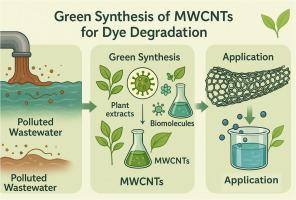Organometallic-inspired green catalysts: Biogenic synthesis of metal-decorated multi-walled carbon nanotubes for efficient dye remediation
IF 2.1
3区 化学
Q3 CHEMISTRY, INORGANIC & NUCLEAR
引用次数: 0
Abstract
The persistent presence of synthetic dyes in wastewater poses significant environmental challenges, necessitating innovative and sustainable approaches for their effective removal. This review article explores the green synthesis of Multi-Walled Carbon Nanotubes (MWCNTs) and their promising applications in dye degradation. Traditional synthesis methods of MWCNTs often involve hazardous chemicals and energy-intensive processes, prompting a shift towards greener alternatives. The green synthesis of MWCNTs employs eco-friendly routes, such as plant extracts, microbial synthesis, and biomolecule-assisted methods, aligning with the principles of green chemistry. This review systematically examines the various methodologies of green synthesis, highlighting the chemical and biological mechanisms that underpin these processes. Additionally, the characterization techniques used to evaluate the structural and functional attributes of green-synthesized MWCNTs are discussed in detail. The application section focuses on the adsorption mechanisms of dyes on MWCNTs, factors influencing degradation efficiency, and the comparative performance of green-synthesized MWCNTs against conventionally produced counterparts. Emphasis is placed on case studies that demonstrate the practical efficacy of these nanomaterials in removing dyes from aqueous solutions. Despite the potential benefits, challenges such as scalability, cost-effectiveness, and environmental impacts of large-scale production remain. This review underscores the necessity for ongoing research and development to overcome these barriers, thereby advancing the field of sustainable nanotechnology for environmental applications. The article concludes by proposing future directions and research opportunities to enhance the synthesis and application of green-synthesized MWCNTs in dye degradation, paving the way for sustainable wastewater treatment solutions.

有机金属激发的绿色催化剂:用于染料高效修复的金属修饰多壁碳纳米管的生物合成
废水中持续存在的合成染料对环境构成了重大挑战,需要创新和可持续的方法来有效去除它们。本文综述了多壁碳纳米管(MWCNTs)的绿色合成及其在染料降解中的应用前景。传统的MWCNTs合成方法通常涉及危险化学品和能源密集型过程,促使其向更环保的替代品转变。绿色合成MWCNTs采用植物提取物、微生物合成、生物分子辅助等环保途径,符合绿色化学原理。这篇综述系统地考察了绿色合成的各种方法,强调了支撑这些过程的化学和生物机制。此外,还详细讨论了用于评价绿色合成的MWCNTs的结构和功能属性的表征技术。应用部分侧重于染料对MWCNTs的吸附机理、降解效率的影响因素,以及绿色合成的MWCNTs与常规生产的MWCNTs的性能比较。重点放在案例研究上,证明这些纳米材料在去除水溶液中的染料方面的实际功效。尽管有潜在的好处,但大规模生产的可扩展性、成本效益和环境影响等挑战仍然存在。这篇综述强调了克服这些障碍的持续研究和开发的必要性,从而推动可持续纳米技术在环境应用领域的发展。文章最后提出了未来的方向和研究机会,以加强绿色合成的MWCNTs在染料降解中的合成和应用,为可持续的废水处理解决方案铺平道路。
本文章由计算机程序翻译,如有差异,请以英文原文为准。
求助全文
约1分钟内获得全文
求助全文
来源期刊

Journal of Organometallic Chemistry
化学-无机化学与核化学
CiteScore
4.40
自引率
8.70%
发文量
221
审稿时长
36 days
期刊介绍:
The Journal of Organometallic Chemistry targets original papers dealing with theoretical aspects, structural chemistry, synthesis, physical and chemical properties (including reaction mechanisms), and practical applications of organometallic compounds.
Organometallic compounds are defined as compounds that contain metal - carbon bonds. The term metal includes all alkali and alkaline earth metals, all transition metals and the lanthanides and actinides in the Periodic Table. Metalloids including the elements in Group 13 and the heavier members of the Groups 14 - 16 are also included. The term chemistry includes syntheses, characterizations and reaction chemistry of all such compounds. Research reports based on use of organometallic complexes in bioorganometallic chemistry, medicine, material sciences, homogeneous catalysis and energy conversion are also welcome.
The scope of the journal has been enlarged to encompass important research on organometallic complexes in bioorganometallic chemistry and material sciences, and of heavier main group elements in organometallic chemistry. The journal also publishes review articles, short communications and notes.
 求助内容:
求助内容: 应助结果提醒方式:
应助结果提醒方式:


